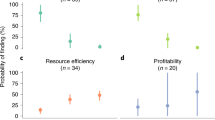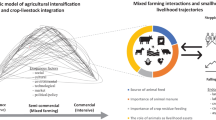Abstract
Although medium-scale farms are more prevalent than large-scale farms in many sub-Saharan African countries, much less is known about their interactions with, and influence on, small-scale farms. In Tanzania, medium-scale farms are more likely to use modern techniques and inputs and to market their output, suggesting a potential for spillover effects for their smaller-scale neighbors—particularly if they attract local agribusiness investments. We consider the population of small-scale farms in Tanzania and ask whether agricultural behaviors and outcomes are affected by the local prevalence of medium-scale farms. Using pooled OLS and household fixed-effects models, we find evidence that small-scale farms are more likely to use improved seed, to cultivate more of their landholdings, and to receive agricultural extension in the presence of more medium-scale farms. This points to positive synergies from mixed scales of farming in a given locality.
Resumé
Bien que les exploitations agricoles de taille moyenne soient plus répandues que les exploitations à grande échelle dans de nombreux pays d'Afrique subsaharienne, nous ne disposons que de peu d’information à propos de leur interaction et de leur influence sur les petites exploitations. En Tanzanie, les exploitations agricoles de taille moyenne sont plus susceptibles d'utiliser des techniques et des intrants modernes et de commercialiser leur production, ce qui peut potentiellement entraîner des répercussions positives sur leurs voisins de plus petite taille, en particulier si ces exploitations agricoles moyennes attirent des investissements agro-industriels au niveau local. En observant les petites exploitations agricoles en Tanzanie, nous nous demandons si leur comportement et leur rendement agricole sont impactés par la présence d’exploitations de taille moyenne dans leur localité. Grâce à la combinaison de la méthode des moindres carrés ordinaire et du modèle d'effets fixes sur les ménages, nous prouvons que les petites exploitations agricoles, en présence d'exploitations de taille moyenne, sont plus susceptibles d'utiliser de meilleures semences, de cultiver une plus grande partie de leur propriété foncière et de bénéficier d'une vulgarization agricole. Cela indique que dans une localité donnée, il existe des synergies positives entre les exploitations agricoles de taille différente.

Similar content being viewed by others
Notes
References
Ahlerup, P., and S. Tengstam. 2015. Do the land-poor gain from agricultural investments? Empirical evidence from Zambia using panel data. Working paper in economics No. 624. University of Gothenburg: Gothenburg.
Ali, D.A., K. Deininer, and A. Harris. 2017. Using national statistics to increase transparency of large land acquisition: Evidence from Ethiopia. World Development 93: 62–74.
Ali, D.A., K. Deininger, and A. Harris. 2019. Does large farm establishment create benefits for neighboring smallholders? Evidence from Ethiopia. Land Economics 95: 71–90.
Ango, T.L. 2018. “Medium-scale” forestland grabbing in the Southwestern Highlands of Ethiopia: Impacts on local livelihoods and forest conservation. Land 7 (1): 24. https://doi.org/10.3390/land7010024.
Anseeuw, W., T. Jayne, R. Kachule, and J. Kotsopoulos. 2016. The quiet rise of medium-scale farms in Malawi. Land 5 (3): 19.
Baumgartner, P., J. Von Braun, D. Abebaw, and M. Muller. 2015. Impacts of large-scale land investments on income, prices, and employment: Empirical analyses in Ethiopia. World Development 72: 175–190.
Chamberlin, J., and T.S. Jayne. 2020. Does farm structure affect rural household incomes? Evidence from Tanzania. Food Policy 90: 101805.
Collier, P., and S. Dercon. 2014. African agriculture in 50 years: Smallholders in a rapidly changing world? World Development 63: 92–101.
Deininger, K., and F. Xia. 2016. Quantifying spillover effects from large land-based investment: The case of Mozambique. World Development 87: 227–241.
Deininger, K., and F. Xia. 2018. Assessing effects of large-scale land transfers: Challenges and opportunities in Malawi’s estate sector. World Development 104: 281–296.
Greene, W. 2004. Fixed effects and bias due to the incidental parameters problem in the Tobit model. Econometric Reviews 23 (2): 125–147.
HarvestChoice. 2015. Tropical livestock units. https://harvestchoice.org/maps/total-livestock-population-tlu-2005. Accessed 22 Sept 2018.
Hazell, P., and A. Rahman. 2014. Concluding chapter: the policy agenda. In New directions for smallholder agriculture, ed. P. Hazell and A. Rahman, 527–558. Oxford: Oxford University Press.
Herrmann, R., and U. Grote. 2015. Large-scale agro-industrial investments and rural poverty: Evidence from sugarcane in Malawi. Journal of African Economies 24 (5): 645–676.
Houssou, N., X. Diao, and S. Kolavalli. 2014. Can the private sector lead agricultural mechanization in Ghana? Ghana Policy Note No. 4. Washington: International Food Policy Research Institute.
Houssou, N., A. Chapoto, and C. Asante-Addo. 2016. Farm transition and indigenous growth: The rise to medium- and large-scale farming in Ghana. Discussion Paper No. 01499. International Food Policy Research Institute: Washington.
Jayne, T.S., J. Chamberlin, L. Traub, N. Sitko, M. Muyanga, F.K. Yeboah, W. Anseeuw, A. Chapoto, A. Wineman, and C. Nkonde. 2016. Africa’s changing farmland ownership: The rise of medium-scale farms. Agricultural Economics 47S: 197–214.
Larson, D., R. Muraoka, and K. Otsuka. 2016. Why African rural development strategies must depend on small farms. Global Food Security 10: 39–51.
Lay, J., K. Nolte, and K. Sipangule. 2018. Large-scale farms and smallholders: Evidence from Zambia, GIGA Working Papers, No. 310. German Institute of Global and Area Studies (GIGA): Hamburg.
Losch, B., S. Freguin-Gresh, and E.T. White. 2012. Structural transformation and rural change revisited: Challenges for late developing countries in a globalizing world. World Bank: Washington.
National Bureau of Statistics (NBS). 2012. National Sample Census of Agriculture 2007/08—large-scale farms. NBS: Dar es Salaam. https://catalog.ihsn.org/index.php/catalog/3794.
National Bureau of Statistics (NBS). 2014. Basic information document, National Panel Survey 2012–13. Dar es Salaam: NBS.
Neven, D., M.M. Odera, T. Reardon, and H. Wang. 2009. Kenyan supermarkets, emerging middle-class horticultural farmers, and employment impacts on the rural poor. World Development 37 (11): 1802–1811.
Nolte, K., and M. Ostermeier. 2017. Labour market effects of large-scale agricultural investment: Conceptual considerations and estimated employment effects. World Development 98: 430–446.
Nolte, K., and K. Sipangule. 2017. Land use competition in Sub-Saharan Africa's rural areas. EGNet Policy Brief, No. 10/2017. Kiel Institute for the World Economy (IfW), Poverty Reduction, Equity and Growth Network (PEGNet): Kiel.
Oakland Institute. 2011. Understanding Land Investment Deals in Africa: Ethiopia, Mail, Sierra Leone, Mozambique, South Sudan, Tanzania, and Zambia. https://www.oaklandinstitute.org/special-investigation-understanding-land-investment-deals-africa.
Shete, M., and M. Rutten. 2015. Impacts of large-scale farming on local communities’ food security and income levels—empirical evidence from Oromia Region, Ethiopia. Land Use Policy 47: 282–292.
Sitko, N.J., and T.S. Jayne. 2014. Structural transformation or elite land capture? The growth of ‘emergent’ farmers in Zambia. Food Policy 48: 194–202.
Sitko, N.J., W.J. Burke, and T.S. Jayne. 2018. The quiet rise of large-scale trading firms in East and Southern Africa. Journal of Development Studies 54 (5): 895–914.
Tittonell, P., and K. Giller. 2012. When yield gaps are poverty traps: The paradigm of ecological intensification in African smallholder agriculture. Field Crops Research 143 (1): 76–90.
Van den Broek, G., J. Swinnen, and M. Maartens. 2017. Global value chains, large-scale farming, and poverty: Long-term effects in Senegal. Food Policy 66: 97–107.
Wineman, A., and T.S. Jayne. 2018. Land prices heading skyward? An analysis of farmland values across Tanzania. Applied Economics Perspectives and Policy 40 (2): 187–214.
Wineman, A., and T. S. Jayne. 2020. Factor market activity and the inverse farm size-productivity relationship in Tanzania. Journal of Development Studies. https://doi.org/10.1080/00220388.2020.1797686.
Wineman, A., T.S. Jayne, E.I. Modamba, and H. Kray. 2020. The changing face of agriculture in Tanzania: Indicators of transformation. Development Policy Review. https://doi.org/10.1111/dpr.12491.
Wooldridge, J. 2002. Econometric analysis of cross section and panel data. Cambridge: Institute of Technology Press.
Acknowledgements
This research was produced under the World Bank activity “Closing the Potential-Performance Divide in Tanzanian Agriculture.”
Funding
This work was jointly funded by the World Bank under the activity “Closing the Potential-Performance Divide in Tanzanian Agriculture” and by the USAID/Bureau for Food Security under the Agriculture Sector Policy and Institutional Reforms Strengthening project (ASPIRES/Tanzania) of Michigan State University.
Author information
Authors and Affiliations
Corresponding author
Ethics declarations
Conflict of interest
On behalf of all authors, the corresponding author states that there is no conflict of interest.
Additional information
Publisher's Note
Springer Nature remains neutral with regard to jurisdictional claims in published maps and institutional affiliations.
Rights and permissions
About this article
Cite this article
Wineman, A., Jayne, T.S., Modamba, E.I. et al. Characteristics and Spillover Effects of Medium-Scale Farms in Tanzania. Eur J Dev Res 33, 1877–1898 (2021). https://doi.org/10.1057/s41287-020-00323-7
Accepted:
Published:
Issue Date:
DOI: https://doi.org/10.1057/s41287-020-00323-7




